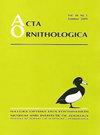热带猫头鹰在哪里栖息:多尺度栖息地变量解释印度安达曼群岛两种同域Otus物种的栖息地选择
IF 1.3
4区 生物学
Q3 ORNITHOLOGY
引用次数: 0
摘要
摘要了解同域物种之间的生态位分化,使物种能够共存并分配资源,是生态学的核心概念。在此背景下,我们利用多尺度方法评估了安达曼群岛两种同域猫头鹰——安达曼鸮Otus balli和东方鸮Otus sunia在栖息地资源上的差异。我们在三个不同的尺度(树木、斑块和宏观)上测量了影响猫头鹰栖息地点的变量。分别有38个和69个独立栖息点被记录下来。我们发现这两个物种在树尺度上对槟榔科植物表现出高度的偏好,可能是因为它们的刺状结构可以提供保护。但两个物种在斑块和宏观尺度上表现出不同的选择模式。在斑块尺度上,球蚜选择树木相对成熟(树高、胸围和冠层盖度较高)、林下盖度(林下盖度、高度和草本成分)较厚的斑块为栖息地。与此相反,苏木叶蠹选择次生林或高度扰动林的树木。土地利用和土地覆盖类型在宏观尺度上区分了两种物种及其栖息地偏好,预测重叠度非常低。balli的潜在栖息地面积比O. suunia小得多。我们的研究结果表明,这两个同域物种对栖息地点的偏好是由安达曼群岛常绿森林的特征决定的。因此,对这种森林类型的任何进一步改变都可能对地方性的球孢粉孢产生不利影响。本文章由计算机程序翻译,如有差异,请以英文原文为准。
Where do the Tropical Owls Roost: Multiscale Habitat Variables Explain Roost Site Selection by Two Sympatric Otus Species in the Andaman Archipelago, India
Abstract. Understanding the niche differentiation between sympatric species that permit species to coexist and partition resource is the central concept in ecology. In this context, we evaluated the differences in roost site resources between two sympatric Otus species — Andaman Scops-owl Otus balli and Oriental Scops-owl Otus sunia in the Andaman Islands using a multi-scale approach. We measured variables that influence roost site use by owls at three different scales (tree, patch and macro). A total of 38 and 69 independent roost locations of O. balli and O. sunia respectively were recorded. We found that both species showed a high preference for Arecaceae plants at tree scale, possibly for their spiny structures that could offer protection. But both species showed different selection patterns at the patch and macro scales. At the patch scale, O. balli selected roosting sites in patches with relatively mature tree stands (characterised by higher tree height, girth at breast height and canopy cover) with thick understory cover (understory cover, height, and herbaceous elements). In contrast, O. sunia was found to select trees in secondary or highly disturbed forests. Land use and land cover types distinguish both species from their habitat preferences at a macro scale with a very low predicted overlap. The area of potential roost sites is very low for O. balli when compared to O. sunia. Our findings suggest that the two sympatric species' preferences for roost sites are shaped by the characteristics of evergreen forests of the Andaman Islands. Hence, any further changes to this forest type may have adverse effects on the endemic O. balli.
求助全文
通过发布文献求助,成功后即可免费获取论文全文。
去求助
来源期刊

Acta Ornithologica
生物-鸟类学
CiteScore
2.10
自引率
0.00%
发文量
14
审稿时长
>12 weeks
期刊介绍:
Publishes scientific papers (original research reports, reviews, short notes, etc.) and announcements from all fields of ornithology. All manuscripts are peer-reviewed.
Established in 1933 as Acta Ornithologica Musei Zoologici Polonici, since 1953 continued under the present title.
Published twice a year by the Natura Optima Dux Foundation under the auspices of the Museum and Institute of Zoology, Polish Academy of Sciences.
 求助内容:
求助内容: 应助结果提醒方式:
应助结果提醒方式:


